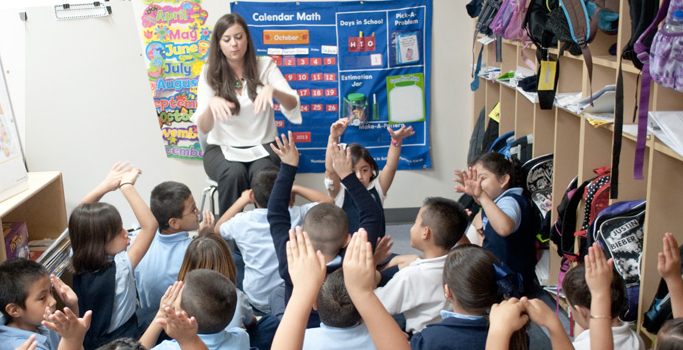
Last week I attended a really insightful panel at Momentous Institute. It was filled with education experts who discussed the latest research on birth-to-5 parent-child interactions. Among other things, they discussed how the said research is being translated (or not) into therapeutic and education practice, especially when dealing with poor English language learners in public schools. (For background on the many challenges ELL students face, read the articles in KERA’s excellent series called American Graduate: Generation One.)
The panel had some heavyweight speakers. It included Alison Sparks from Amherst College, who has done ground-breaking work on the social origins of early language and literacy learning in children from diverse backgrounds; and Margaret Owen, director of the Center for Children and Families at UTD, among others. (The full lineup is here.) I missed Sparks’ pre-panel presentation of her research, but from the panel discussion and from reading her work linked to above, I was able to gather that it focused on the relationship between early learning success and “high point narrative” interaction between parents and their children. (The definition of high point narrative: “personal narratives … organized to contain orienting information, a complicating event, which leads to a high point, and then some kind of resolution, and a coda.”) In other words, it looked at how important storytelling is to the development of our children.
You should read the entire paper about her studies in Costa Rica and the application of her findings to the school environment. But here is are the two takeaway:
High point narrative is a canonical form of storytelling for middle-class children from European-American backgrounds. Narrative development within this cultural group tends to nurture the ability to tell independent stories that are tightly organized and centered on a single and clearly identifiable topic (Melzi, 2000; Michaels& Cook-Gumperz, 1979). A pervasive finding in studies of reminiscing in middle-class families is that the narrative contributions of adults are aimed at stimulating the child’s ability to tell high-point stories that focus on and extend a single event. The use of high-point narrative structure is believed to facilitate communication and success from the earliest school experiences in which children acquire the language and literacy they will need to succeed in later academic work.
In other words, when you read about the 30 million word gap between poor kids and wealthy kids by age 3, understand that it’s not really word-count deficits that doom the kids. It’s that they haven’t been taught how to see the world in a way that fosters rapid cognitive development — i.e., the thing that good storytelling structure teaches kids.
As Owen put it: “Fluid and connected conversation — in words, shared emotions, and symbols — far better predicted language success in young children than did number of words spoken.” As Sparks later noted, “The high-point narrative structure is the gateway to language mastery. … It’s storytelling, not just saying “I went to McDonald’s yesterday.”
The panel discussed what this means in terms of successes and (mostly) challenges in today’s early education environment. (Note: This is all slightly above my pay grade, so if I make some false assumptions or misstate research, please correct me in the comments.) One aspect they covered was the importance of dual language programs, ELL kids speak both English and Spanish. ‘m still getting my head around the different arguments for dual language vs. Spanish immersion approach used by places like Mi Esquelita preschool, which has a stellar reputation. But in each case, it’s clear that Spanish speaking when necessary for greater understanding between parents and children is not only encouraged but necessary. “If you’re boosting ESL [English as a Second Language) skills, you’re boosting English skills,” Sparks said. “Speaking English-only [in a Spanish-speaking home] has a negative effect.”
This gets to several challenges faced by Alan Cohen, DISD’s early education chief, who was also on the panel. Cohen talked about how DISD’s teachers all get early childhood-to-6th grade training, which is another way of saying they get very little specialized training on how to teach 3- and 4-year-olds. Which means the teacher herself or the district must do on-the-job training. He and Owen engaged in a dialogue how procedures for higher-grade teachers could be misapplied to pre-K kids. Cohen pointed out that teachers in DISD and everywhere are constantly told these days to “teach with more rigor.” And, as Owen pointed out, pre-K teachers need to understand that often means “let them play” when it comes to 3- and 4-year-olds, because that’s the environment in which their own personal narratives and high-level stories are worked and shared. Owen recounted a story about one teacher responding to the “more play” directive by saying, “I might lose control.” The entire room reacted with head shakes and loud murmuring.
Cohen also said that one of his challenges is building a database of information for kids from birth to 5, not just K through 12, so they have an idea of where a kid is at developmentally when she walks into kindergarten. He closed by talking about how difficult it is to take this type of research to scale in a district as big as Dallas ISD because “it costs money. These [poor] kids require excellence to succeed, and excellence is expensive.” He then asked each audience member to call her or his state legislator’s office and demand the Ledge fun full-day pre-K. “The way they do the math, they assume every call represents 100 people,” Cohen says.
This is on my to-do list, btw. Should be on yours, too.





